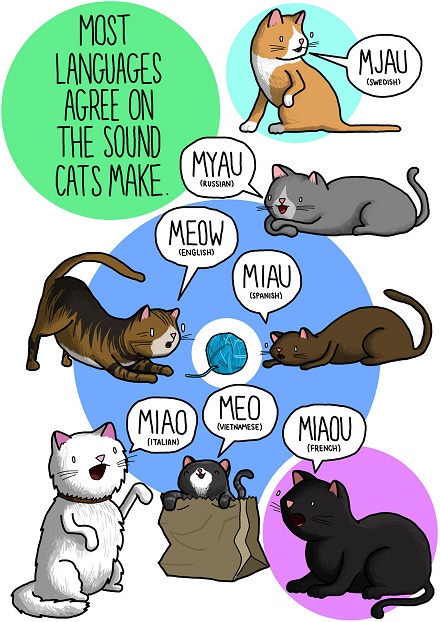Summary | Excerpt | Reviews | Beyond the Book | Read-Alikes | Genres & Themes | Author Bio

Around the World in Twenty Languages
by Gaston DorrenThis article relates to Babel
 In Babel: Around the World in 20 Languages, Gaston Dorren writes about how Korean includes separate words for different kinds of meows. One word refers to the ordinary cry, and a different word is used to describe a more urgent vocalization. With this information, Dorren illustrates how sounds are indicative of a language's idiosyncrasies.
In Babel: Around the World in 20 Languages, Gaston Dorren writes about how Korean includes separate words for different kinds of meows. One word refers to the ordinary cry, and a different word is used to describe a more urgent vocalization. With this information, Dorren illustrates how sounds are indicative of a language's idiosyncrasies.
The way people write out animal sounds varies from language to language, but some things remain the same. In any language, these noises frequently consist of the same word repeated twice. The pigs that "oink oink" in English go "knor knor" in Dutch, "ggool ggool" in Korean, and "boo boo" in Japanese. Similarly, if an animal has a sound that isn't repeated, that also holds true from language to language. English speakers know the rooster goes "cock a doodle do," but in Romanian, it's "cucurigu." In Tagalog, it's "tilaok." Then there is the Swedish "kuckeliku" and the Japanese "kuckeliku." Some animal sounds are more similar the world over, such as the cow's "moo" in English and "boo" in Dutch, likely because these have more obvious onomatopoeia noises.
In addition to there being commonalities among animal sounds among languages, there are also common omissions. When you look up what a penguin says in any language, you're most likely to just find comparisons to other animals (usually donkeys) or evocative descriptions, such as "low speed car crash" for penguins. Scientists who study penguins use the verb "gak" to describe their talking (i.e. "The penguin gaks for his mate to move out of the way"). But still, that's not a transliteration for penguin speech. The absence of a word for this animal's sounds probably reflects the unlikeliness of encountering one in the wild for much of the world. Still, in an age of unlimited adorable penguins on YouTube, and of course the film March of the Penguins, you'd expect there to be a more solidified idea of what their noises sound like.
Famously, the fox also lacks a distinctive word. I say "famously" because this was immortalized in a song by the Norwegian musician Ylvis. In the video to his song "What Does the Fox Say?" he searches for the right word as people in animal costumes dance around. But nobody ever knows what the fox says, simply describing their sounds as some version of barking or yelping. Foxes are certainly more common than penguins, so why do they not have their own sound?
Children are taught animal sounds early on, whether or not they sing "Old MacDonald Has a Farm." Knowing what animals say is so basic, that it's mind-blowing to think something so seemingly intuitive or phonetic like "cock-a-doodle-doo" would have to be translated. The variation among animal sounds in different cultures reminds us at once how alike and how different we are. And it also reminds us that some things are charming in any language.
Illustration of cat sounds, courtesy of James Chapman
Filed under Cultural Curiosities
![]() This "beyond the book article" relates to Babel. It originally ran in January 2019 and has been updated for the
December 2019 paperback edition.
Go to magazine.
This "beyond the book article" relates to Babel. It originally ran in January 2019 and has been updated for the
December 2019 paperback edition.
Go to magazine.
Your guide toexceptional books
BookBrowse seeks out and recommends the best in contemporary fiction and nonfiction—books that not only engage and entertain but also deepen our understanding of ourselves and the world around us.